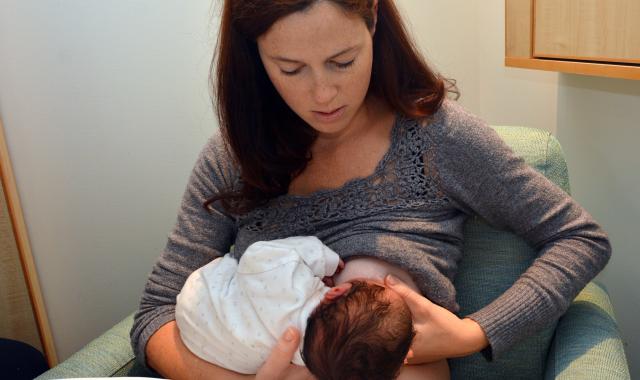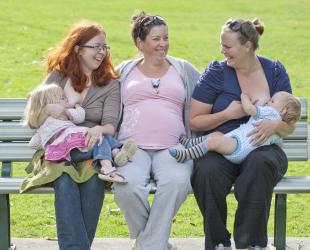Information about sore or damaged nipples
by Simone Casey

Nipple skin is super sensitive and any sort of grazes or cracks on it can cause toe-curling pain. When breastfeeding mums discover their nipples are damaged, just thinking about putting them in their baby’s mouth to suck can send them into floods of tears. I’m hoping to water down some of these floods by explaining how cracks actually happen and what you can do next to help them heal.
I am often asked what types of ointments can fix up nipple cracks and, while some mums find relief with lanolin-based creams or aloe vera-soaked pads (please don’t leave these on too long, they make nipples soggy!), I usually suggest to smear some breastmilk on them after feeds and get to the root of the problem: why the crack occurred in the first place.
Nipples don’t just crack from overuse, from a baby having a strong suck, or because they weren’t toughened up in pregnancy (have you heard the old wives’ tale about rubbing them with steel wool? Ew!). Nipples can split open when the baby’s attachment is too shallow and friction is caused by the nipple rubbing on the hard palate, instead of being lovely and cushioned back in the soft palate.
Now this palate stuff sounds a bit technical, but a simple way to work out where these parts are is to suck your own thumb. When you first put your thumb in your mouth, you can feel the hard roof of your mouth. Push your thumb further back and you will feel the squishiness of the soft palate. That’s where the nipple needs to be in the baby’s mouth so that feeding will be comfortable, although if there is already some damage, it might hurt for the first 30 seconds while the nipple is being drawn back in baby’s mouth.
If you can get attachment right for 100 per cent of feeds, the cracks can be well on their way to being healed soon. So persist if you can (even in the middle of the night when you’re exhausted and just think to yourself ‘it hurts but they’re on, I’m just going to leave it’). If there’s pinching or ongoing pain, break the seal of baby’s mouth, take them off and start again. Sometimes, though, no matter how hard you try, you can’t get to 100% pain free each time you latch your bub. This is when I suggest using a pain scale. If the pain is intense when you first attach, this may be an 8, 9 or 10 out of 10. After you wait 30 seconds, if this has subsided as low as a 2 or 3 out of 10 and that’s the best you can do, sometimes it’s worth letting bub stay in this latch rather than relatch over and over and over again and baby never gets fed. If you can get a better latch for most feeds, you are on your way to pain-free feeding, but remember you are both learning and it’s OK to make mistakes while you are practising.
If you can’t get your baby’s mouth wide enough to get the nipple all the way to the back, you may need to adjust your positioning or hold. I reckon it’s best if you can get an ABA counsellor or lactation consultant to have a look at you feed, as they may be able to pick up on something that you’re doing that will make all the difference. In my experience, the most common mistake is not holding a baby close enough in the chest-to-chest-chin-to-breast position, babies then have too far to reach and are half closing their mouth by the time they actually latch. Or mums are ‘nipple stuffing’ — when they are pushing the nipple into bub’s mouth rather than following the adage ‘bring the baby to the breast, not the breast to the baby’.
Breastfeeding isn’t meant to hurt (although there is a learning process to get through in the early days), and putting up with painful nipples is not realistic long-term. Plus, baby isn’t getting the best transfer of milk. So look around you for the right support, and get it sorted before it gets any worse.
Simone Casey is an Australian Breastfeeding Association counsellor and community educator from Northern Melbourne. She’s breastfed three children over nine years and has been volunteering with ABA for over 13 years, with a 6-year stint as group leader of the Pascoe Hume Group and several years as regional representative of the Tullamarine Region. Simone was a journalist for 20 years so has loved combining her writing skills with her breastfeeding knowledge to create blogs for the national website and now recording this podcast series. In 2011 she qualified as an International Board Certified Lactation Consultant and works in a private inner city hospital and runs her own lactation business doing home visits. Her volunteering highlight was at a branch conference in Ballarat when a trainee referred to her as ‘the Kylie Minogue of breastfeeding’.
More information
Is breastfeeding supposed to be painful? How can I prevent or recover from cracked and damaged nipples? In this episode, Nicole and Simone talk about the early days of breastfeeding, sore nipples and some simple management strategies. They will also discuss what to do if these strategies aren’t enough.
-
Access our free info kit.
-
Download our mum2mum app via the App store or Google Play.
-
Call the National Breastfeeding Helpline on 1800 686 268, available 24 hours a day, 7 days a week.
-
Chat with a volunteer via LiveChat on our website.
-
Sign up for an interactive and informative local breastfeeding class or online breastfeeding workshop.
-
Get books and resources on general and specialist breastfeeding topics.
-
Join ABA as a member to get your free copy of our best-selling book Breastfeeding … naturally + free access to all premium content on the mum2mum app + discounted breastfeeding classes + half-price breast pump hire + unlimited access to ABA events + more!



